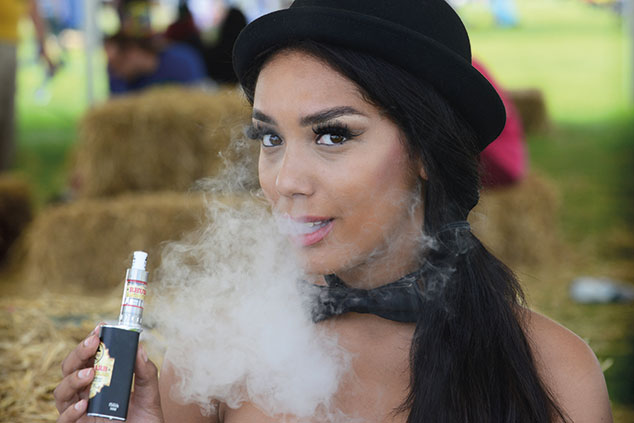
market will be worth $19.3bn this year
What has happened?
There’s been a major public health scare in the US over the safety of e-cigarettes and vaping. In recent weeks, doctors in 33 US states have connected at least 450 cases of lung disease to their patients’ use of e-cigarettes. Seven patients have died so far. In response, the Centers for Disease Control and Prevention has warned people to consider avoiding vaping altogether. And President Trump has announced plans for a complete ban on flavoured e-cigarettes, which are blamed for a surge in vaping’s popularity among high-school students. No one knows for sure what has caused the wave of pulmonary disease – or even if it is in fact caused by, or merely correlated with, the use of e-cigarettes. Some reports suggest those affected have mostly been users of unlicensed street-bought products containing cannabis, rather than regulated shop-bought products. Even so, the regulatory and reputational fallout has the potential to devastate the industry – and dash the hopes of Big Tobacco that vaping might prove to be its commercial saviour.
What exactly are e-cigarettes?
They are electronic devices that deliver nicotine (or cannabinoids, if that’s your bag) via the inhalation of vaporised liquid instead of smoke. This liquid isn’t exactly appetising: it typically contains nicotine, propylene and glycerin, plus other chemicals and flavourings. But vaping allows users to avoid the nasty byproducts of combustion that end up killing half of smokers and – in the UK at least – is viewed chiefly as a tool for quitting smoking. Since e-cigarettes were launched at the start of the decade, so-called “open tank” vapes – in which there’s a removable mouthpiece and the vaporised liquid is manually refilled by the user – have dominated the market. “Closed tank” vapes, which use ready-made refills that screw directing onto the device’s battery, have in the past year caught up in popularity, and are expected to account for the vast bulk of future growth in the global market.
How big is that market currently?
According to Euromonitor International, the global e-cigarette and vaping products market will be worth $19.3bn this year, a near-tripling from just $6.9bn five years ago. The same firm projects that market to continue growing fast, to $45bn by 2023. By far the biggest market is the US, accounting for more than a third of the total. The UK is the second biggest – followed (with less than half the size of the UK market) by France, Germany, China and Canada. Worldwide, it’s estimated that there are 41 million vapers, a big jump from 11 million in 2011. It’s still small compared with Big Tobacco, accounting for 7% of the overall US nicotine market. But it’s a profitable slice that’s growing fast, and is crucial to the industry’s future.
Is vaping safe?
The advice from Public Health England is clear: “If you don’t smoke, don’t vape,” says John Newton, its director of health improvement. “But if you smoke there is no situation where it would be better for your health to continue smoking rather than switching completely to vaping.” PHE’s advice remains that e-cigarettes are 95% less dangerous than smoking tobacco and using them “makes it much more likely you’ll quit successfully than relying on will power alone.” But just because something is far less dangerous than cigarettes doesn’t make it completely safe. Vaping hasn’t been going long enough for a scientific consensus to emerge on the level of danger, but some studies do suggest an increased risk to lung and heart health.
Should vaping be banned?
That would be a ridiculous overreaction, reckons The Economist. Some governments – in Egypt, Mexico, Singapore, Taiwan and Brazil – have indeed banned e-cigarettes over safety fears. But, as ever, prohibition will do more harm than good. “Forbidding e-cigarettes will lead vapers to buy illicit products – the type that are far more likely to poison them. It will also deter many law-abiding smokers from switching to something less deadly.” That said, the US, where far more previously non-smoking teens have taken up recreational vaping than in Britain, might well want to follow the EU (including the UK), where advertising is tightly controlled and there are much lower limits on levels of (addictive) nicotine.
What’s the impact on business?
Intriguingly, tobacco stocks rose when the US unveiled its flavour ban, as investors bet that if users can’t get their preferred flavour of vapes, they are more likely to take up or revert to the real thing. But it’s more likely that in the long run the vaping scare will prove very bad news indeed for Big Tobacco, argues Sergei Klebnikov in Forbes. The scare has already thrown the $200bn merger between Altria (the US maker of Marlboro) and Philip Morris International into uncertainty, due to the “greatest regulatory threat” faced by Big Tobacco since the 1990s. Both companies (which demerged in 2008) have invested heavily in e-cigarettes and cannabis products in an attempt to offset falling tobacco sales.
What have they done?
Altria, for example, paid $12.8bn last year for a 35% stake in Juul, the San Francisco-based company that dominates the US market for flavoured vapes, plus $1.8bn for 45% of cannabis firm Cronos. In the UK, tighter regulation would also be a headache for London-listed firms with big e-cigarette investments, including British American Tobacco and Imperial Brands, says Andrew Edgecliffe-Johnson in the FT. Like Altria and Philip Morris, both firms have invested heavily in alternatives to tobacco in response to consumer demand. In the case of BAT, it recently announced 2,300 job losses, specifically pledging to direct the cost savings into developing new products. If the regulatory climate does turn against vaping, at least some of that strategy might have just gone up in smoke.